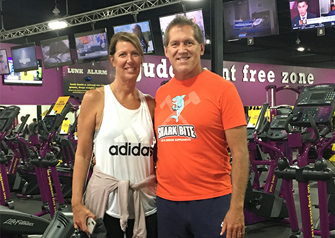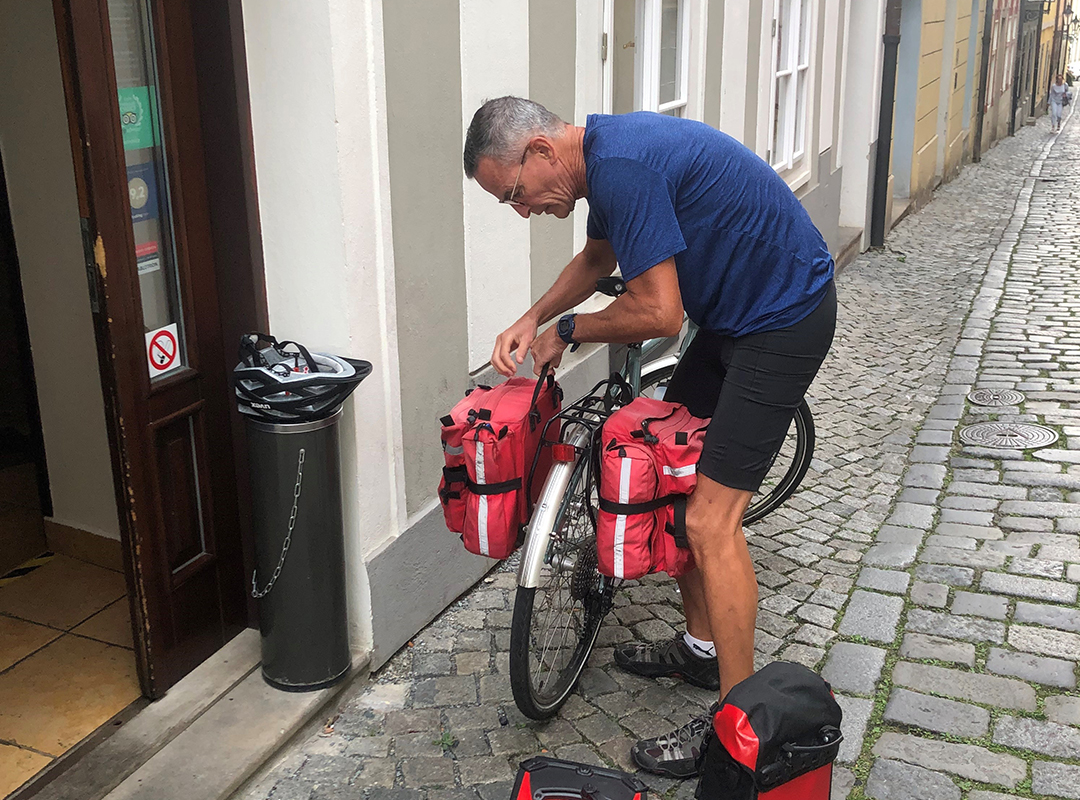
Patient Stories
“Two thumbs up” for Dr. Della Valle and staff after partial knee replacement
Date posted: 10/5/2020
Last updated: 10/5/2020
When Charles Rupert, 56, of Champaign decided to do something about his nagging knee pain, he assumed a total knee replacement was in his future. With two knee surgeries already under his belt, he was willing to do whatever it might take to be comfortable standing at work and fully active again.
“I’m a big workout guy, usually in the gym three to four days a week,” he explains. “But for years, I’ve only been able to work out my upper body because of my knee pain. I just knew it was time.”
Willing to travel for the best care, he researched joint replacement physicians in Chicago and found highly rated Dr. Craig Della Valle of Midwest Orthopaedics at Rush, also Professor of Orthopedic Surgery and Chief of the Adult Reconstruction Service at Rush University Medical Center. Within days he had an appointment. “I wanted to be treated by the best in Chicago,” he says.
What he wasn’t expecting was that ‘the best’ would extend to everyone he met at Midwest Orthopaedics at Rush along the way. It started with the warm welcome he received from the security desk attendant when he arrived at the orthopedic building for his first appointment.
After an examination and thorough review of Rupert’s imaging, Dr. Della Valle gave him good news that the arthritis in Rupert’s knee was contained to one area and that he was a candidate for a partial knee replacement (also called a unicompartmental knee replacement), a smaller operation than a total knee replacement. He described the anatomy of a knee joint which consists of three compartments: the inner (medial) and outer (lateral) compartments, plus the patellofemoral joint where the kneecap (patella) connects to the femur. In Rupert’s case, just the medial compartment had cartilage loss due to arthritis.
“Everything else looked healthy,” explains Dr. Della Valle. “I felt that he would have an excellent outcome with a partial and didn’t want to disturb the non-diseased portions of his knee if I didn’t have to.”
Moving forward with a partial knee replacement
Rupert agreed to the partial replacement surgery and when the day came, he met a couple more ‘bests’ during the day. “When I arrived for surgery, the young man who checked me in was calm, helpful, and reassuring” he explains. “And, the nursing staff made me feel like I was the most important person they were dealing with.”
During the procedure, Dr. Della and the surgical team did their best work. The inner portion of his knee was replaced by making precise bone cuts and replacing the joint with metal caps on the ends of the bones and a plastic liner in between. The surgery was a success.
Six weeks later, Rupert is nearing the end of his physical therapy near his home in Champaign and is already back to his job as a parts manager at a John Deere facility. On his non-physical therapy days, he does exercises at the gym.
Rupert credits his successful recovery to Dr. Della Valle’s professionalism and the daily texts he receives from his care team.
“I love the regular communication,” he says. “It has been really good for my morale during rehab and I even told my physical therapists about them. They had never heard of this kind of follow up and asked me ‘what did he text you today?’”
The technology that Dr. Della Valle uses automates important clinical and supportive information, like physical therapy tips, milestones regarding pain medication and appointment reminders. He incorporates this into his care plan for all patients. “I’ve gotten really good feedback from patients,” he explained. “If we can help them achieve their active lives faster and more smoothly, that’s our goal.”
Rupert remains an advocate for anyone considering knee surgery. “Dr. Della Valle and the whole MOR team have gone above and beyond to care for me,” Rupert says. “I definitely give them two thumbs up.”
If you would like to schedule an appointment to discuss your knee or hip pain with Dr. Craig DellaValle, please call 877-MD-BONES or click here to request an appointment online.


